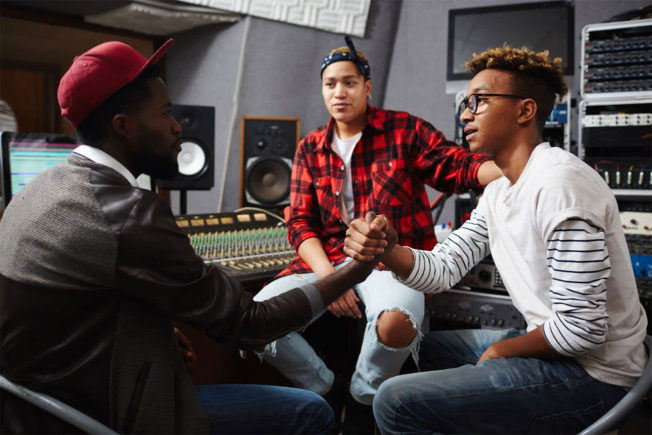What is a songwriter split sheet? Learn how to manage split sheets when collaborating with other artists to ensure you get paid for your work.

What is a Split Sheet?
Songwriter split sheets are an integral part of the music business. A split sheet is a written agreement that identifies each contributor to a song and establishes ownership percentages amongst them. The agreed percentages determine how much each contributor will receive from the royalties generated by their music.
Split sheets are necessary for every song you write with collaborators. They ensure everyone involved in the creative process is properly credited and paid for the work they contributed.
It’s also important to note that split sheets are not a copyright agreement. Copyright ownership is different.
[yuzo]
Why is a Split Sheet Important?
Split sheets are an essential safeguard for all co-creators of a song. They ensure everyone involved in the creation process receives credit and compensation for their work. Split sheets can also save creators from a potential legal headache because it requires them to work out an agreement and establish ownership in writing.
Under U.S. Copyright Law, any co-written content without a written agreement will be equally divided depending on the number of people involved. Without a split sheet, contributing producers and songwriters risk receiving less ownership or revenue for the content they created. This can lead to ugly disputes among each contributor and potential legal battles.
Also, a Performing Rights Organization (PRO), record label, music publisher, music licensor, and any other third-party using the song can hold royalty payments until the conflict resolves. Moreover, contributors risk not getting credit or royalty payments if a company does not know who, or how much to pay.
How to Determine the Ownership Percentage
The final percentage splits are negotiated and agreed upon by all parties involved. The total of all the split percentages must equal 100%. There are different approaches collaborators take to divide split percentages. For example, you can split the rights evenly among each co-writer, or give each person a percentage according to their contribution.
Giving each contributor equal ownership is the safest route to avoid confrontation. Also, treating everyone equally will help form lasting relationships with other artists. It may even boost the chances of them wanting to work with you again.
Determining splits according to a collaborator’s contributions to a song is trickier. Sometimes, not every contributor makes an equal contribution. Or, the contributions by co-writers are not equally significant in the song. For example, one co-writer may add a small part of the lead. Also, the same creator may contribute to both the songwriting and producing process.
Various other factors can further complicate matters. That’s why it’s crucial to figure out splits early. Make sure everyone who contributed to the creative process is on the same page.
When to Create a Split Sheet?
Co-creators often cringe thinking about negotiating ownership and royalty splits. However, navigating this conversation is a necessary practice to ensure you get paid correctly for your work. More important, turning that conversation into a written document proactively protects your rights. It can also save you from a potential legal battle.
It’s best to decide on songwriter splits and get them in writing early in the creative process or as soon as you’ve finished a song. Negotiations may get messy the longer you wait. It’s also easier to negotiate a split sheet before the song starts generating royalties or opportunities arise.
How to Create a Split Sheet
There are three ways to create a split sheet. The latest and most convenient way is with an online service. For example, the free SPLITS app from Create Music Group makes songwriter splits simple.
The SPLITS app helps eliminate songwriting disputes between producers, songwriters, and artists. Collaborators can quickly generate and sign a split agreement in a non-confrontational way, with a few clicks.
You can also find basic split sheet templates online or create your own. A basic split sheet should include:
- The date
- The song title
- Legal names of all contributing writers involved
- Role in the song creation (producer, songwriter, etc.)
- Ownership percentage for each contributor
- Specific contributions (lyrics, hook, melody, beats, etc.)
- Record label (if available)
- Performing Rights Organization (PRO) (if available)
- Publishing company (if available)
- Mailing addresses and contact information
- Signature of each contributor
Ensure each contributing writer fills out all the information that applies to them. Also, register with a Performing Rights Organization (PRO) such as ASCAP, BMI, or SESAC. A PRO helps songwriters and publishers get paid for the use of their music by collecting performance royalties on their behalf.
Conclusion
As a creator, it’s essential to understand the value of your work, especially before it’s published. Also, be proactive and take control of the conversation by using split sheets to secure your fair share of the revenue. Moreover, start negotiation splits early to avoid future disputes. And if you’re having trouble coming up with a fair agreement, get a lawyer!